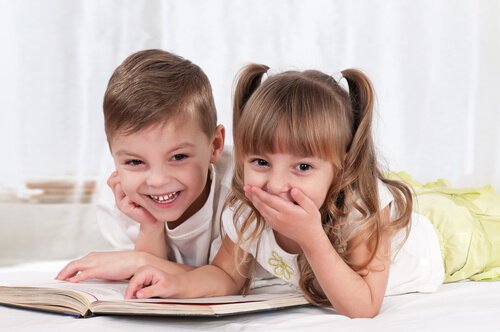7 Games for Learning to Read

Learning through play is always more enjoyable. Here you’ll find a list of games for learning to read that you can use both at school and at home.
The idea is to spark curiosity and interest and encourage children to start to express their own ideas – all through fun and games.
The main stages of learning to read are:
- Pre-syllabic level. Learning to differentiate letters and numbers.
- Syllabic level. Developing phonological awareness and starting to associate sounds with letters. Simultaneously learning to read and write.
These reading games will help your children develop their full cognitive potential in a fun and spontaneous way.
7 Games for Learning to Read
1. Letters with Objects
We can start with a routine where children point to different objects. One by one you tell them the name of the object. It is important to make sure the names are very clear.
You can then use the usual illustrated alphabets or use clay to mold the letters or the objects that you want to teach.
It’s best to start with the vowels and, once they’ve mastered them, continue with the consonants. You can try making letters with your body, using your legs to make an A, for example.
2. Words and Claps
We can get kids interested (and maybe make them laugh as well) by clapping to separate each syllable of a word. For example: Hun-ter, hor-sie, tree, yell-ow.
When writing, clap as they draw a line to separate syllables, continuing the fun on paper as well.
4. Recognizing Vowels
To identify syllables you can use pairs or trios of words that start with the same vowel. For example, elephant, egg, exit, enter.
The purpose is for the child to identify the words and learn the corresponding vowel sound. In the above example they would be consolidating their learning of the letter E in various scenarios.
You can also use letter cards, or baskets, each one representing a vowel. If you can paint them, even better.
For example, A can be yellow, E can be red, and so on. Use cards identified with the vowels. For example, letter A: airplane, apple, ant. Letter O: open, owl, octopus.
4. Linked Drawings
Put eight drawings together in a folder. In each one, on each side, draw pictures that are related and that the child can put together by identifying each one.
The goal is to relate each word. For example on one side you could write: book, bread, dog, and couch. On the other side: pet, food, and house. The child should link: house-book, dog-pet, bread-food, couch-house.
5. Use Syllable Cards
This is another fun and useful game for learning to read. Take some cards and write different syllables on them, as many as necessary. Ask your child to make words starting with each of the cards.
If, for example, you write the syllable PA, ask what words they can think of starting with that syllable. You can put various syllables in a bowl and draw them out. For example: PA, RA, TO, EN, PO.
Ask your child to pick one and say a word that starts with that syllable. For example, paper.
6. Recognize the Letters
As soon as your child starts to learn these letters, start paying special attention to certain letters that are easy to mix up, like b and p, or b and d.
Try writing them several times: b b d b b b. The letter in the middle is different because it isn’t a B. Ask your child to write the correct letter so it will say b b b b b b.

7. Which Word Has the Letter
Another game for learning to read is to write out several words and ask your children to find the ones that have the letter A. You can do this with drawings as well.
For example: banana, leaf, hand, ear, bird. Likewise, you can ask them to color in the words that have the letter A.
This way they construct a reading. The important thing is to connect the pictures and the text. It isn’t about decoding symbols, nor is it mechanical. The important thing is to understand the message.
Remember that the point of these games is for reading to become a tool to help them communicate, discover, and become involved in the world around them.
Learning through play is always more enjoyable. Here you’ll find a list of games for learning to read that you can use both at school and at home.
The idea is to spark curiosity and interest and encourage children to start to express their own ideas – all through fun and games.
The main stages of learning to read are:
- Pre-syllabic level. Learning to differentiate letters and numbers.
- Syllabic level. Developing phonological awareness and starting to associate sounds with letters. Simultaneously learning to read and write.
These reading games will help your children develop their full cognitive potential in a fun and spontaneous way.
7 Games for Learning to Read
1. Letters with Objects
We can start with a routine where children point to different objects. One by one you tell them the name of the object. It is important to make sure the names are very clear.
You can then use the usual illustrated alphabets or use clay to mold the letters or the objects that you want to teach.
It’s best to start with the vowels and, once they’ve mastered them, continue with the consonants. You can try making letters with your body, using your legs to make an A, for example.
2. Words and Claps
We can get kids interested (and maybe make them laugh as well) by clapping to separate each syllable of a word. For example: Hun-ter, hor-sie, tree, yell-ow.
When writing, clap as they draw a line to separate syllables, continuing the fun on paper as well.
4. Recognizing Vowels
To identify syllables you can use pairs or trios of words that start with the same vowel. For example, elephant, egg, exit, enter.
The purpose is for the child to identify the words and learn the corresponding vowel sound. In the above example they would be consolidating their learning of the letter E in various scenarios.
You can also use letter cards, or baskets, each one representing a vowel. If you can paint them, even better.
For example, A can be yellow, E can be red, and so on. Use cards identified with the vowels. For example, letter A: airplane, apple, ant. Letter O: open, owl, octopus.
4. Linked Drawings
Put eight drawings together in a folder. In each one, on each side, draw pictures that are related and that the child can put together by identifying each one.
The goal is to relate each word. For example on one side you could write: book, bread, dog, and couch. On the other side: pet, food, and house. The child should link: house-book, dog-pet, bread-food, couch-house.
5. Use Syllable Cards
This is another fun and useful game for learning to read. Take some cards and write different syllables on them, as many as necessary. Ask your child to make words starting with each of the cards.
If, for example, you write the syllable PA, ask what words they can think of starting with that syllable. You can put various syllables in a bowl and draw them out. For example: PA, RA, TO, EN, PO.
Ask your child to pick one and say a word that starts with that syllable. For example, paper.
6. Recognize the Letters
As soon as your child starts to learn these letters, start paying special attention to certain letters that are easy to mix up, like b and p, or b and d.
Try writing them several times: b b d b b b. The letter in the middle is different because it isn’t a B. Ask your child to write the correct letter so it will say b b b b b b.

7. Which Word Has the Letter
Another game for learning to read is to write out several words and ask your children to find the ones that have the letter A. You can do this with drawings as well.
For example: banana, leaf, hand, ear, bird. Likewise, you can ask them to color in the words that have the letter A.
This way they construct a reading. The important thing is to connect the pictures and the text. It isn’t about decoding symbols, nor is it mechanical. The important thing is to understand the message.
Remember that the point of these games is for reading to become a tool to help them communicate, discover, and become involved in the world around them.
All cited sources were thoroughly reviewed by our team to ensure their quality, reliability, currency, and validity. The bibliography of this article was considered reliable and of academic or scientific accuracy.
- Aguirre, R. (2004). La lectura y la escritura en la escuela. En J. Peña González y S. Serrano de Moreno (Comps.), La lectura y la escritura en el siglo XXI (pp. 70-79). Mérida. Venezuela: CDCHT – ULA.
- Cassany, D. (1996). Describir el escribir. Cómo se aprende a escribir. Barcelona, España: Pai-dós Ibérica S. A.
- Fons, M. (2001). Enseñar a leer y a escribir. En Didáctica de la lengua en la educación infantil. Monserrat, Bigas y Monserrat Correig (Edits.) pp. 179-212. Madrid: SÍNTESIS, S. A.
- Villalobos, J. (2006). La lectura y la escritura como herramientas para el desarrollo del cono-cimiento y aprendizaje. En J. Peña González y S. Serrano de Moreno (Comps.), La lectura y la escritura. Teoría y práctica (pp. 33-58). Mérida. Venezuela: Consejo de Desarrollo Científico Humanístico y Tecnológico y Consejo de Estudios de Postgrado Universidad de Los Andes.
- Vygotsky, L. (1979). El desarrollo de los procesos psicológicos superiores. Barcelona: Grijalbo.
This text is provided for informational purposes only and does not replace consultation with a professional. If in doubt, consult your specialist.








